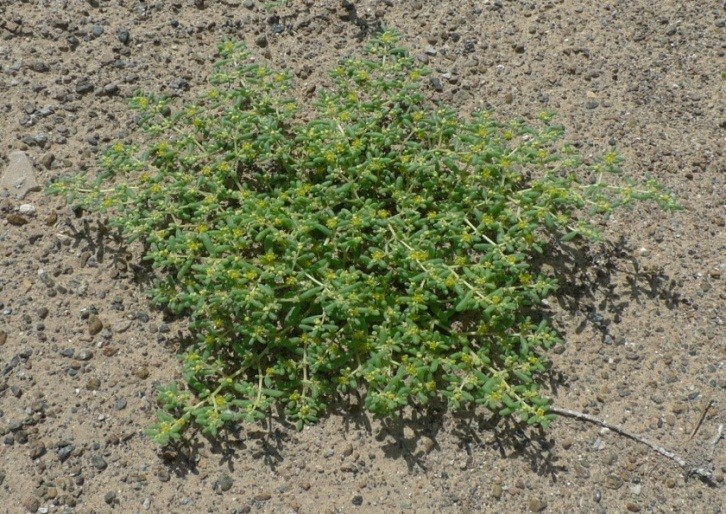
Zygophyllum simplex / هرم
Zygophyllum portulacoides Forssk.
Harem, Gurmal, Qurmal, Gormeial.
Simple Zygophyllum
Harem
Zygophyllaceae

Flowers
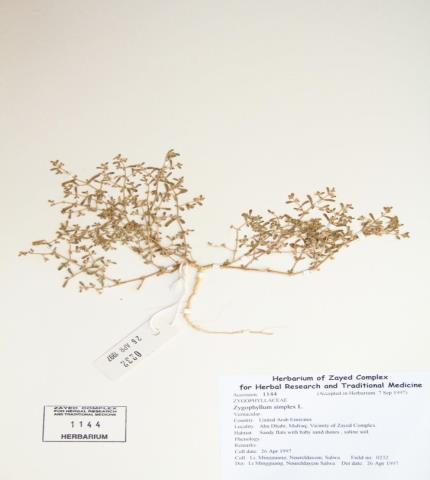
Herbarium specimen
Ethnobotanical Characteristics
Description
Annual, suberect to procumbent, 8-20 cm tall, profusely branched, glabrous herb. Stem and branches pale-green or purplish, minutely striate. Leaves succulent, simple, sessile, oblong-cylindric, 4-18 mm long, apex obtuse; stipules lanceolate, 2-3 mm long, acute. Flowers yellow, fading to white, 4-5 mm across; pedicels slender, 3 mm long; disc 10-lobed. Sepals 5, elliptic-oblong, 2 mm long, keeled, cucullate. Petals 5, spathulate, 3 mm long, truncate at the apex. Stamens 10, exserted, scales bipartite. Carpels 5; ovary ovoid, glabrous, sulcate, 5-loculed, each locule 4-ovuled; style persistent. Capsule deflexed, turbinate, rugulose, retuse, septicidally dehiscent into 5, 2-3 seeded, compressed cocci. Seeds oblong. (Jongbloed et al. 2003, e-Floras,).
Habitat and Distribution
Pakistan (Sind, Baluchistan), India, Iran, tropical and northern Africa, Cape Verde Islands and west Asia. Common in sandy or rocky and saline habitats in Sind and Baluchistan.
Common on limestone along Arabian Gulf littoral, in central desert areas and along east coast as well as foothills. Rare in deep sand; rapidly colonizes gypseous soils and locally dominant annual west of Jebel Dhanna. Southwestern Asia; throughout Arabia, common after the rains (Western, 1989, Ghazanfar, 1994).
Part(s) Used
Whole plant
Traditional and Medicinal Uses
The leaves are used to treat infected eyes. Extract of leaves applied to red or swollen eyes; also uses recorded in Saudi Arabia. The infusion of the leaves and seeds is applied to eyes in Opthalmia and Leucoma. The seeds are anthelmintic. The herb is eaten by camels (Ghazanfar, 1994, e-Floras).
Pharmacognosy and Phytochemistry
Plant material studied
stem and leaf
General appearance
The leaf is grey in colour, small in size (2-8 mm long) and oblong in shape with a short petiole. It is cylindrical in shape when fresh but is shrinks in size on drying. It is brittle and in dried herbs; it is usually found detached from its branch.
Microscopic characteristics
The leaf is cylindrical in shape; thus, dorsal and ventral sides are not well differentiated. A transverse section of the leaf shows the outline of a doughnut shape where the supposed ventral and dorsal sides are at the canter and the margins are at distal ends. The epidermises form a continuous rosary of cells, which are comparatively large, and they bulge out in forms of small arches. They have thick walls and they contain matters of a light greenish-yellow colour and small particles. They also bear few small oval stomata. The epidermises are covered with striated and rectangular networks. The mesophyll is not well-differentiated into palisade and spongy cells; rather, it is composed of very large elongated translucent cells with irregular shapes. However, their cell walls are quite visible and the cell walls of a group of cells look like intermixed light yellowish threads. They contain large grayish angular amorphous masses, which might be mucilaginous materials. They also contain coloured particles. The mesophyll cells imbed intricate venation of vascular tissues.
Plant material studied
Dried stem and branches
General appearance
The cylindrical stem is divided into many branches which are yellow in colour and have many internodes that are bases of their sub-branches. The branches are slender, circular in outlines and glabrous and they bear some remnants of leaves.
Microscopic characteristics: A surface view of the epidermal layer shows that it consists of longitudinal parenchymatous cells that occasionally imbed oval stomata. In section view, the epidermal cells are shown to bulge outwards into small arches. The outer part of the underlying cortex is supported by a layer of long compactly packed rectangular yellow fibers. This fibrous layer readily coils when removed. It is underlain by a layer of elongated parenchyma cells that contain cluster crystals of calcium oxalate arrange in a characteristic pattern forming a straight line along each cell exhibiting bead-like structures. The vascular tissues are compactly arranged forming a circle and occupying a wide zone separated by layers of medullary rays. They are heavily lignified and the xylem vessels are annularly, spirally or reticulately thickened while the tracheids are broad with pitted cell walls. The vascular tissues are underlain by a layer of compactly packed, rectangular yellow-coloured fibers with thick walls followed by square-shaped parenchyma cells of layers of oblong cells and those layers adjacent to the vascular tissues are compressed. The central part of the pith usually separates into a hollow zone.
Parts studied
Leaf and stem
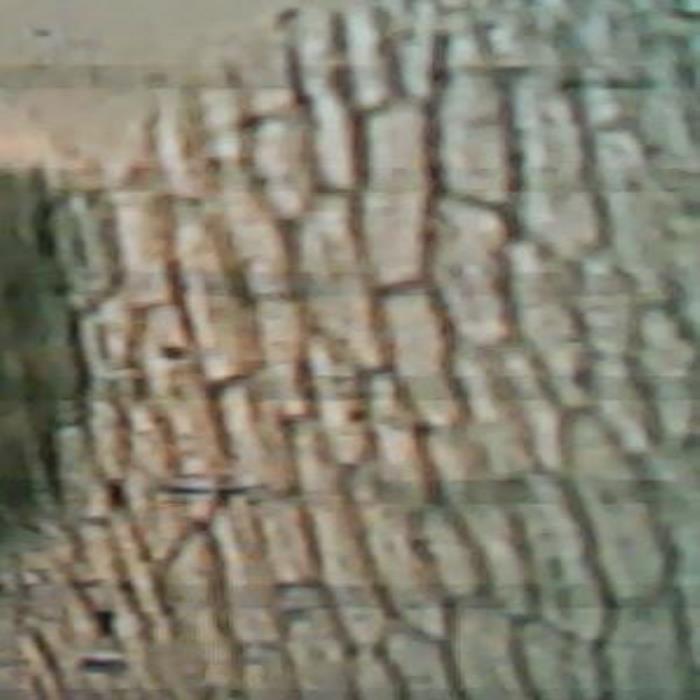
A) Oblique section of leaf
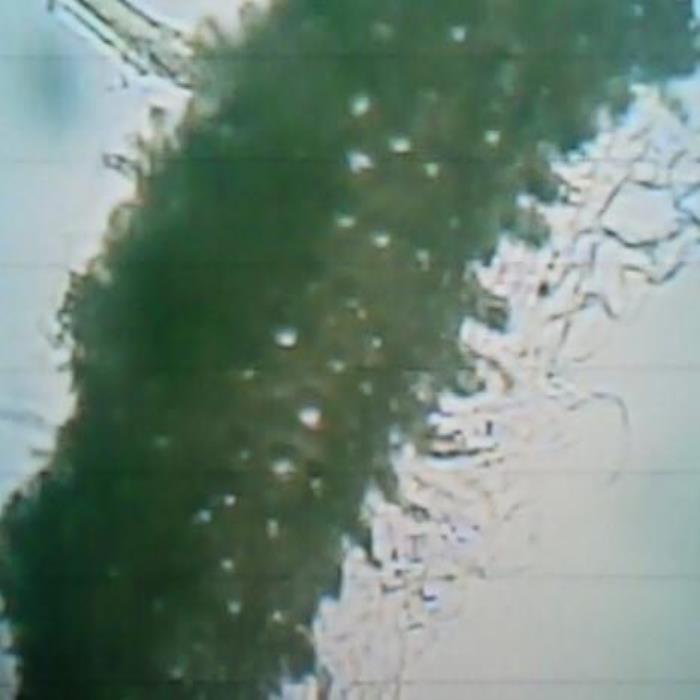
B) Stem epidermis
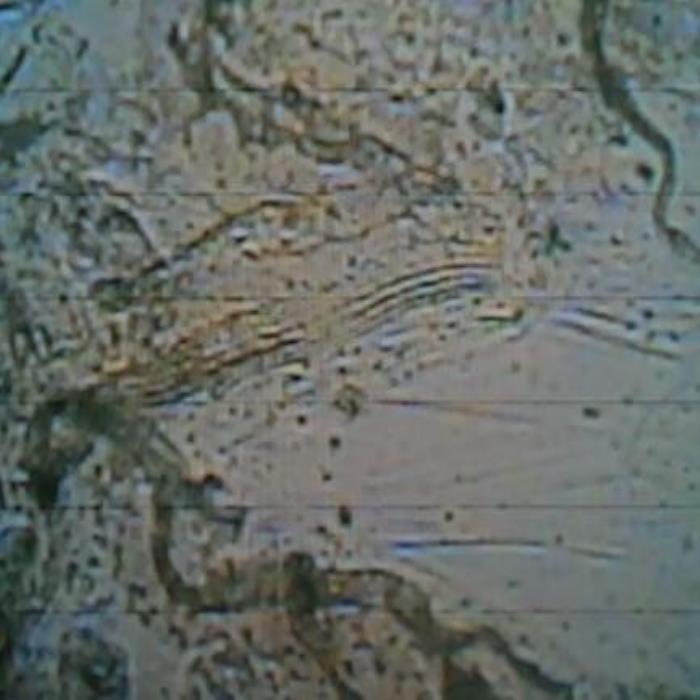
C) TS of stem
- A. An oblique section of a portion of the leaf at the mesophyll region showing the large elongated translucent cells with irregular shapes-thick zigzagging thread-like structures are parts of the shredded epidermis.
- B. A surface view of the stem epidermis showing its longitudinal parenchymatous cells with comparatively thick walls.
- C. A TS of a portion of the stem from which the outer layers including the layer of the compactly packed rectangular yellow fibers. Shown are the heavily lignified vascular tissues (dark zone), a layer of the yellow-coloured fibers, square-shaped parenchyma cells then the oblong cells of the pith and part of the hollow zone.
Chemical constituents
Aerial parts contain a glycoside as 6″-(2-E-butenoyl) isorhamnetin-3-O-glucoside in addition to compounds: isorhamnetin, isorhamnetin 3-O-glucoside, kaempferol 3-O-rutinoside, sitosterol glucoside and quinovic acid 3-α-l-rhamnoside. (Hassanean, 1992) Alkaloids, sterols and/or terpenes, tannins and flavonoids identified as kaempferol 3-glucoside and quercetin 3,7 diglucoside (Ghazanfar, 1994).
The following chemical studies have been carried out on the plant Zygophyllum simplex (Quality Control methods, 1998; Evans, 1996; ZCHRTM unpublished work)
Physicochemical constants
Loss of weight in drying at 105°C : 14.00
Absolute alcohol solubility : 4.60
Water solubility : 45.40
Successive extractives (%)
Petroleum ether 60-80°C : 1.50
Chloroform : 1.00
Absolute alcohol : 12.10
Ash values (%)
Total ash : 32.00
Water soluble ash : 18.84
Acid insoluble ash (10% HCl) : 0.33
pH values (aqueous solution)
pH of 1% solution : 5.856-5.871
pH of 10% solution : 5.380-5.385
Elemental analyses
Ash values (British Herbal Pharmacopeia)
Assay and identification of element (AOAC International)
|
Apparatus |
(AA-6800 Shimadzu-Flame method) |
||||
|
Element |
Std. conc. µg/ml(ppm) |
Sampleconc.mg/ml |
Sample absorbance |
Actual conc.mg/ml |
Actual conc. (%) |
|
Cr |
1, 2, 4 |
20 |
0.018 |
0.0181 |
0.00181 |
|
Zn |
0.25, 0.5, 1 |
20 |
0.975 |
0.04755 |
0.004755 |
|
Cu |
1, 2, 4 |
20 |
0.0489 |
0.0138200 |
0.0013820 |
|
Fe |
1, 2, 4 |
20 |
0.8456 |
0.355935 |
0.0355935 |
|
K |
1, 2, 4 |
1 |
1.2140 |
10.9247998 |
1.09247998 |
|
Pb |
1, 2, 4 |
20 |
0.0002 |
0.0003 |
0.00003 |
|
Cd |
0.25, 0.5, 1 |
20 |
0.0095 |
0.00044 |
0.000044 |
|
Ca |
5, 10, 20 |
1 |
0.1807 |
33.89939 |
3.389939 |
| 1ppm conc. = 1µg/ml; Actual conc. (%) =Actual conc. (ppm)x0.0001 [1ppm=0.0001%] | |||||
UV Spectral studies
|
Ultraviolet Spectrum (USP reference) |
||||
|
Apparatus |
Milton Roy Spectronic Genesys 5 Spectrophotometer - Milton Roy. |
|||
|
Sample conc. (mg / ml) |
Solvent |
λ max (nm) |
λ min (nm) |
Abs. (λ max - λ min) |
|
1.0875 |
Intestinal Fluid simulated without pancreatic pH=7.50.1 |
268 |
253 |
0.517 - 0.493 |
|
1.08 |
Gastric Fluid simulated without pepsin pH =1.20.1 |
265 |
247 |
0.610 - 0.589 |
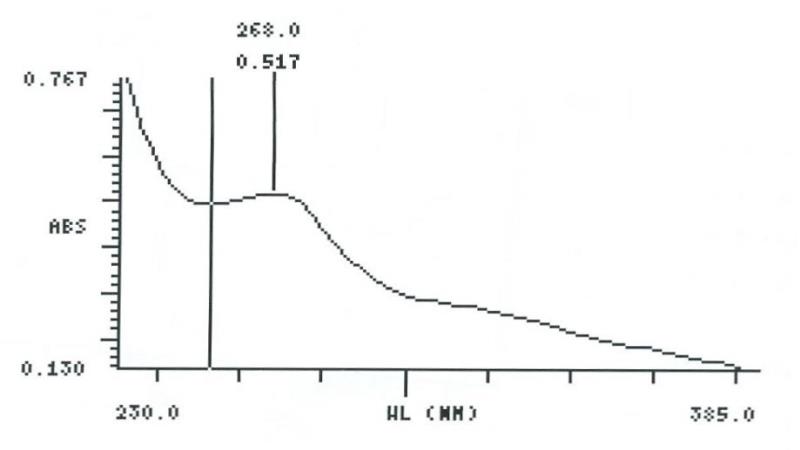
Intestinal Fluid simulated without pancreatic
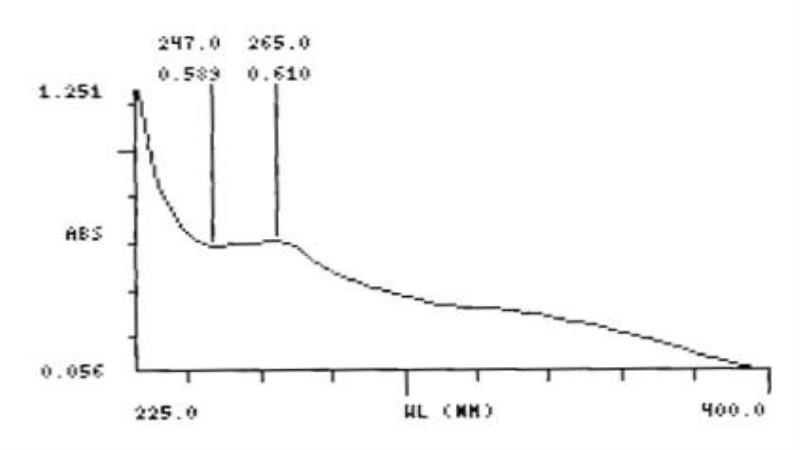
Gastric Fluid simulated without pepsin
Chromatographical Studies
Thin layer chromatography (TLC): Wagner and Bladt, 1996

A

B

C

D
TLC fingerprint of Petroleum ether 60-80°C (track 1) and MeOH extract (track 2)
|
Mobile phase Fig. |
A&C |
: |
Toluene, ethyl acetate (93:7) |
|
|
B |
: |
Ethyl acetate, methanol, water (100:13.5:10) |
|
|
D |
: |
Toluene, ethyl formate, formic acid (5:4:1) |
|
Detection |
C |
: |
UV 366nm |
|
Derivatization |
A,B&D |
: |
Vanillin-Sulphuric acid –vis. |
Pharmacological and toxicological studies
The pharmacological toxicological information reported in the literature about the plant:
The plant Zygophyllum simplex has been reported to have toxicity potential similar to the toxicity of Z. coccineum (Sharawy, 2009).
The plant Zygophyllum quatarense has been tested for its cytotoxic activity by the brine shrimp method (Taha, 2000). Leaf extracts from the drug plants Zygophyllum simplex, collected from the desert region in Abha, Saudi Arabia, was assessed for toxicity against the fourth and fifth nymphal instars of the desert locust Schistocerca gregaria. The leaf extract of the toxicity studies, including analysis of biochemical and hematological parameters and by anatomo-histopathological studies, was carried out on Zygophyllum gaetulum aerial parts used in the traditional treatment of diabetes mellitus in Morocco (Skim, 1999).
The plant was found effective in nymph condition. The plant extracts of Z. simplex could be considered for use in integrated pest management programs for the control of S. gregaria (Abdullah, 2000). Roots and aerial shoot of Zygophyllum coccineum L. tested against spore germination of Verticellium albo-atrum and Fusarium oxysporum. Petroleum ether extracts were ineffective as fungistatic, while the methanol extracts possessed a high inhibitory effect toward spore germination suppression, depending on the fungus and plant species. Water or ethyl acetate root extracts of Z. album caused a marked suppression of spore germination of the test fungi. Some of the isolated saponins and kaempferol provided successful control against the test plant pathogens under greenhouse experiment when used as seed treatment (Ouf, 2008).
The aqueous leaf extract Zygophyllum gaetulum, at a single oral dose (440 mg/kg) produced a significant hypoglycemic effect is 6 h after administration. The same dose ingested twice daily resulted in a significant reduction of blood glucose during the first week, and maintained the patient in normoglycemia throughout the two-week course of treatment, with no change in body weight (Jaouhari, 1999). Zygophyllum gaetulum showed a significant hypoglycemic effect in normal as well as in hyperglycemic rats (Skim, 1999).
The effects of an aqueous extract of Zygophyllum coccineum L. on rat blood pressure (BP) and on the mesenteric vascular bed concluded that extract of Z. coccineum possess significant antihypertensive activity that may involve some membrane hyperpolarization (Gibbons et al., 2001).
The following pharmacological and safety evaluation studies were carried out at ZCHRTM (Derelanko 2002; Han, 2003) on the 70% alcohol extract of Zygophyllum simplex.
|
ACTIVITY |
RESULTS |
|||
|
Strong |
Moderate |
Mild |
Negative |
|
|
Analgesic (Hot plate) |
√ |
|
|
|
|
Anti-inflammatory (rat paw edema) |
√ |
|
|
|
|
Anti-inflammatory (Cotton pellet) |
√ |
|
|
|
|
Anti-diabetic activity |
|
|
√ |
|
|
Anti-gastric ulcer effect (NaOH and 80% ethanol rat models) |
√ |
|
|
|
|
Effect on rabbit jejunum |
√ |
|
|
|
|
Effect on rat fundus |
√ |
|
|
|
|
Effect on right rat atria (force and HR) ↑ |
|
|
√ |
|
|
Effect on rabbit corpus cavernous strip |
|
|
|
√ |
|
Effect on guinea pig tracheal chain |
|
|
√ |
|
|
Endocrinological effect |
|
|
|
√ |
|
Acute toxicity on mice |
|
|
√ |
|
|
Locomotor activity test ↓ |
|
|
√ |
|
|
Motor co-ordination (grip strength & motor activity)↑ |
|
|
√ |
|
|
Rectal temperature |
|
|
|
√ |
|
Body weight |
|
|
|
√ |
|
Mortality |
|
|
|
√ |
|
LD50 |
> 5 g/kg p.o. in mice |
|||
Summary of the results
The plant extract was administered at a dose of 1g/kg daily for ten days exhibited mild hypoglycemic activity; showed significant analgesic activity and acute as well as sub-acute significant anti-inflammatory activity as compared to the control. Two experimental models validated these effects. It had significant inhibition of gastric mucosal damage induced by NaOH and Ethanol -induced gastric ulcers, caused a strong spasmogenicity followed by relaxation at the higher dose showing bowl function regulation activity. The plant extract displayed spasmogenic effects that reflect constipation relieving and the digestive and carminative properties of the plant. It increased the force of contraction effect on right isolated rat atria showing the significant positive inotropic property on rat atria in vitro. The endocrinological studies showed no change in hormonal quantification, and no hormonal imbalance found. Plant extract produced a no change in phenylephrine-pre-contracted corpus cavernous tissue. The treated animals showed insufficiency of the sexual response. The plant extract showed mild relaxant effect on tracheal chain broncho-constrictory effect induced by histamine.
The animal at the dose of 5g/kg showed restricted movement, straub tail within half an hour; piloerection, urination, eyes dropping and diarrhea in some of the animals. No death was recorded. Some animals showed drowsiness, ptosis, preening. One animal showed staggering of the body. However, string and pole test was found negative. The LD50 of aqueous extracts of the plant was found to be greater than 5g/kg, when administered once via gastric intubation to mice. The plant extract was found relatively toxic.
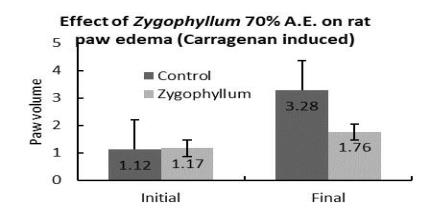
Effect on rat paw edema

Spontaneous contraction effect on rabbit jejunum
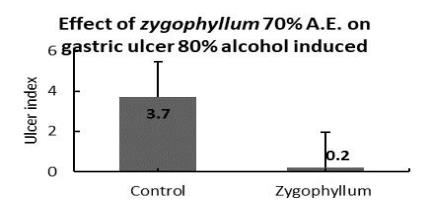
Effect on gastric ulcer
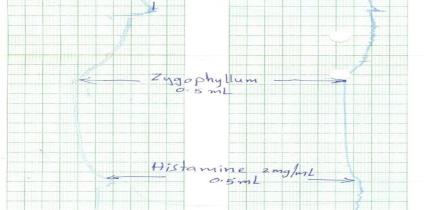
Effect on Guinea pig tracheal chain
Antimicrobial activity
The aqueous extract of the whole plant was tested against Mycobacterium smegmatis, Candida tropicalis, different strains of Staphylococcus aureus (Including ATCC 257), strains of Methicillin Resistant Staphylococcus aureus, strains of E. coli (Including ATCC UN 109), different strains of ESBL-producing K. pneumonia, E. coli, Pseudomonas aeruginosa, and showed no inhibition of growth.
References
- Abdullah, M. A. (2000). Toxicity assessment of calotropis procera and zygophyllum simplex leaf extracts on the desert locust schistocerca gregaria orthoptera acrididae . Arab Gulf Journal of Scientific Research, 18, 157-164.
- Ahmed Taha, HashimAlsayed. (2000). Brine shrimp bioassay of ethanol extracts of Sesuvium verrucosum, Salsolabaryosma and Zygophyllum quatarense medicinal plants from Bahrain, 14; 48-50.
- Bauer AW, Kirby WMM, Sheriss JC, Turck M. (1966) Antibiotic susceptibility testing by standardized single method. Am J Clin Pathol; 45:493–6.
- British Herbal Pharmacopoeia (1996).4th Ed.: British Herbal Medicine Association (BHMA).
- Derelanko, M. J., & Hollinger, M. A. (2002). Hand book of toxicology. (2nd ed.). Boca Raton, USA: CRC Press.
- Evans, W.C (1996).Trease and Evans’ Pharmacognosy,(14th ed,p.105 )Saunders ,London.
- El-Ghonemy, A. A. (1993). Encyclopedia of Medicinal plants of the United Emirates. (1st ed.). University of U.A.E.
- Fawzi, M. K. (1995). Weeds in the United Arab Emirates. University of U.A.E.
- Flora of Pakistan; www.efloras.org
- Ghazanfar, S. A. (1994). Handbook of Arabian Medicinal Plants. Boca Raton, USA: CRC Press.
- Han, J., & Hoosier, G. L. V. J. (2003). Hand book of laboratory science, animal models. (Second ed., Vol. II). USA: CRC Press.
- Hassanean, H. A., &Desoky, E. K. (1992).An acylated isorhamnetin glucoside from Zygophyllum simplex.Phytochemistry, 31(9), 3293-3294.
- Jaouhari,J.T Lazrek, H.B SeddikA and Jana.M (1999).Hypoglycaemic response to Zygophyllum gaetulum extracts in patients with non-insulin-dependent diabetes mellitus Journal of Ethnopharmacology. 64: 211-217.
- Jonbloed, M. V., Feulner, G. R., Boer, B. & Western, A. R. (2003).The comprehensive Guide to the Wild Flowers of the United Arab Emirates, Erwda, Abu Dhabi, U.A.E.
- Mandaville, J. P. (1990). Flora of Eastern Saudi Arabia.Kegan Paul International, Riyadh, Saudi Arabia.
- Mothana R A A, Abdo SA ,Hasson S, Althawab FM, Alaghbari SA, Lindquist U.( 2008) Antimicrobial, antioxidant and cytotoxic activity and phytochemical screening of some Yemeni medicinal plants. Evid Based Complment Alternat Med. 7(3):323-30.
- Gibbons, S andOriowo.S (2001).Antihypertensive effect of an aqueous extract of Zygophyllum coccineum in rats.Phytotherapy Research, 15: 5452-455.
- Official Methods of Analysis of AOAC International (1999).16th. Ed.Vol.I and II.
- Ouf, F K Abdel Hady, M H ElGamal and K H.Shaker..(2008). Isolation of antifungal compounds from some Zygophyllum species and their bioassay against two soil-borne plant pathogens Folia Microbiologica, Folia microbilogia, 39: 215-221.
- Quality control methods for medicinal plant materials (1998).World Health Organization, Geneva.
- Sherif M Sharawy and Ahmed M Alshammari.(2009).Checklist of Poisonous Plants and Animals in Aja Mountain, Ha'il Region, Saudi Arabia.Australian Journal of Basic and Applied Sciences, 3: 2217-2225.
- Skim F, Lazrek HB, Kaaya A, el Amri H, Jana M. (1999). Pharmacological studies of two antidiabetic plants: Zygophyllum gaetulum.Therapie, 54:711-715.
- Wagner, H. Bladt, S.(1996). Plant Drug Analysis-A Thin layer Chromatography Atlas, (2nd Ed.) Springer-Verlag, Berlin Heidelberg.
- Western, A. R. (1986). The Flora of United Arab Emirates. An introduction. –Al Ain.
- Western, A. R. (1989). The Flora of United Arab Emirates- An introduction. Publications of the U.A.E. University.
- ZCHRTM unpublished work.
